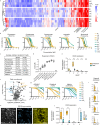Divergent WNT signaling and drug sensitivity profiles within hepatoblastoma tumors and organoids
- PMID: 39567475
- PMCID: PMC11579375
- DOI: 10.1038/s41467-024-52757-w
Divergent WNT signaling and drug sensitivity profiles within hepatoblastoma tumors and organoids
Abstract
Hepatoblastoma, the most prevalent pediatric liver cancer, almost always carries a WNT-activating CTNNB1 mutation, yet exhibits notable molecular heterogeneity. To characterize this heterogeneity and identify novel targeted therapies, we perform comprehensive analysis of hepatoblastomas and tumor-derived organoids using single-cell RNA-seq/ATAC-seq, spatial transcriptomics, and high-throughput drug profiling. We identify two distinct tumor epithelial signatures: hepatic 'fetal' and WNT-high 'embryonal', displaying divergent WNT signaling patterns. The fetal group is enriched for liver-specific WNT targets, while the embryonal group is enriched in canonical WNT target genes. Gene regulatory network analysis reveals enrichment of regulons related to hepatic functions such as bile acid, lipid and xenobiotic metabolism in the fetal subtype but not in the embryonal subtype. In addition, the dichotomous expression pattern of the transcription factors HNF4A and LEF1 allows for a clear distinction between the fetal and embryonal tumor cells. We also perform high-throughput drug screening using patient-derived tumor organoids and identify sensitivity to HDAC inhibitors. Intriguingly, embryonal and fetal tumor organoids are sensitive to FGFR and EGFR inhibitors, respectively, indicating a dependency on EGF/FGF signaling in hepatoblastoma tumorigenesis. In summary, our data uncover the molecular and drug sensitivity landscapes of hepatoblastoma and pave the way for the development of targeted therapies.
© 2024. The Author(s).
Conflict of interest statement
Competing interests: H.C. is currently head of pharma Research Early Development (pRED) at Roche and is an inventor on several patents related to organoid technology. His full disclosure is given at www.uu.nl/staff/JCClevers . The remaining authors declare no competing interests.
Figures







References
-
- Meyers, R. L., Aronson, D. C. & Zimmermann, A. Pediatric Surgery (Seventh Edition, 2012).
-
- Ranganathan, S., Lopez-Terrada, D. & Alaggio, R. Hepatoblastoma and Pediatric Hepatocellular Carcinoma: An Update. Pediatr. Dev.Pathol.23, 79–95 (2020). - PubMed
-
- Dasgupta, P. et al. Global trends in incidence rates of childhood liver cancers: A systematic review and meta‐analysis. Paediatr. Périnat. Epidemiol.34, 609–617 (2020). - PubMed
-
- Perilongo, G. et al. Cisplatin versus cisplatin plus doxorubicin for standard-risk hepatoblastoma. N. Engl. J. Med.361, 1662–1670 (2009). - PubMed
Publication types
MeSH terms
Substances
Grants and funding
LinkOut - more resources
Full Text Sources
Medical
Research Materials
Miscellaneous

